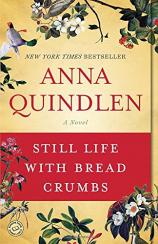Still Life with Bread Crumbs
Review
Still Life with Bread Crumbs
Backward or forward. Reverse or drive. No idling when telling a good story. Anna Quindlen manages both directions nicely in her newest novel, STILL LIFE WITH BREAD CRUMBS. She tackles the ugly question: After being successful for several decades, how do I approach the next part of my life?
Rebecca Winter had been a prominent photographer with a fabulous reputation and a handsome income that she earned for a series of Kitchen Counter pictures taken impulsively after a dinner party: the handful of greasy forks, a bottle lying on its side with a puddle of olive oil, and the final one --- a composition of wine glasses, stacked plates, torn ends of baguettes, and a worn dish towel. Still Life with Bread Crumbs caught the imagination of like-minded New Yorkers and then women around the globe. They saw the beauty and the story behind them. Rebecca enjoyed the fame and fortune that came her way, even as her surprising success niggled at her husband’s pride. A Rebecca Winter photograph meant something.
However, the years have gone by and Rebecca has become less popular, selling fewer photographs and reproductions. After she and her husband divorce, she is left with bills and responsibilities and a lifestyle she can no longer afford. She knows she is yesterday’s news. Her agent tells her everyone was waiting and wanting to see what was next. Rebecca acknowledges to herself that she, too, wants to see what is next.
"Backward or forward. Reverse or drive. No idling when telling a good story. Anna Quindlen manages both directions nicely in her newest novel, STILL LIFE WITH BREAD CRUMBS. She tackles the ugly question: After being successful for several decades, how do I approach the next part of my life?"
In a surprising move to cut expenses, she sublets her West Side apartment at an exorbitant rate and leases a cabin, sight unseen, in upstate New York. She arrives at the cabin and settles in, but it is worse than primitive --- it is primitive and has a raccoon living in the attic. She decides that the cottage was the real estate version of online dating, built atop lies, leading downhill to disenchantment. But she has no other option, so she stays.
Nestled in the woods beginning at her back door, Rebecca looks for inspiration. The early photographs of a dry stone wall and of a paper wasp nest amounted to nothing; they were failures because they had to be explained. Days and weeks go by as she adapts to the country lifestyle, and on a hike one afternoon she finds a small white cross, three feet high, with a volleyball trophy resting at its base --- too odd, too out-of-place, too freshly planted. Rebecca takes several photographs, but the next morning when she returns, it is gone.
The mystery of the cross and the ensuing finds in the caves and hills near her cottage interest her but cannot sustain her. Friendships in the small town nearby develop, and she occasionally touches base with her former life. As an only child, Rebecca is responsible for her mother, who now plays Bach mindlessly and ceaselessly in the Jewish Home for the Aged and Infirm. Her father lives in a cottage nearby, to make visits easier for Rebecca, but he has no grasp of the downward spiral of her life. Her adult son is ungrounded and floundering; her photography agent is mean.
In moments of quietness and solitude, Rebecca reveals her understanding of the human condition. Years earlier, she had been in her New York apartment and heard the sound of someone wailing and weeping. The walls were thick, it was an old building, and the sobbing must be loud for her to hear it. She wants to call 911, to whisper into the phone that someone’s heart is breaking in apartment 8C. But she realizes the police could never keep up with all the breaking hearts in apartments in New York. Then she imagines the sadness that caused this weeping --- an illness, a lost lover, a dead parent --- and knows there were so many ways to imagine someone unhappy and so few to imagine someone contented.
Another part of Rebecca is that she seems oblivious to some important aspects of her earlier life; that very relatable obtuseness makes her believable and worth getting to know. Taking a child to school, buying food for dinner and going to the dry cleaners is what many of us do on a regular basis. And most of us at age 60 or thereabouts question just exactly what was going on while we were doing all that. Rebecca’s gradual awareness of what she has been doing for 60 years and her growing appreciation for other things feels genuine.
Early in her career, Rebecca responded to an interviewer’s question about the origins of her art. Everything is accidental, she says. She later regrets being flippant about the ephemeral quality of art but knows it is accurate. Throughout this year of her life, she repeatedly shows that she knows art when she is in its presence. She knows which photographs are real and true, and this confidence makes her worth knowing as well.
Anna Quindlen wraps up Rebecca’s year-long adventure perhaps too predictably. Many pieces of her life fall into place, and she has the immense satisfaction of standing away from the New York art scene. She also has the satisfaction of another beginning, most likely an even more exciting time of her life. Predictable or not, it is the sort of ending we imagine for ourselves.
Reviewed by Jane Krebs on January 31, 2014
Still Life with Bread Crumbs
- Publication Date: October 28, 2014
- Genres: Fiction, Women's Fiction
- Paperback: 288 pages
- Publisher: Random House Trade Paperbacks
- ISBN-10: 0812976894
- ISBN-13: 9780812976892





